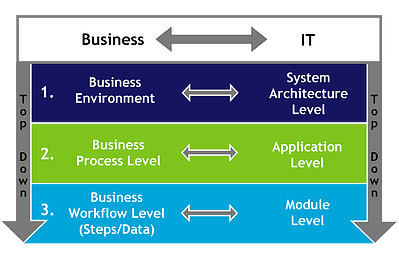While modern solution development allows for fast implementation and change, it would be a wrong conclusion to believe that process solution requirements don’t have to be fully specified and documented upfront. Comprehensive analysis of such requirements and tight change management are essential for project success. We therefore will recap the aspects of successful requirement capturing.
Process solution requirements need to be
- Complete: End-user expectations need to be fully captured and conceptualized so all required functionalities are considered.
- Accurate: Requirements need to be consistent across all steps and stakeholders, and should be described clearly so everyone can understand them. Relevant limitations or restrictions need to be well known.
- Verifiable: Along with these requirements, methods need to be specified in order to define how requirements can be measured and when they are fulfilled.
- Necessary: Above all, requirements need to be relevant to business goals and prioritized according to their impact. This will help make smart choices when designing and implementing the solution.
It is highly recommended to fully document the requirements and handle all additions that come up after finalizing the requirements phase through change management. To minimize the impact of changes in a later phase, it is important to carefully listen to all stakeholders of the solution and avoid thinking about implementation when capturing the requirements.
Using a structured approach for capturing user expectations, eases the process and ensures all aspects are adequately covered. Ultimus recommends a phased approach in its methodology and workshops that has proven to be successfully within many years of project experience.
Phase 1)
Initially, it is important to understand the user environment, which impacts solution architecture. Requirements like organizational structure, locations, network access and communication, response times, integration needs etc. are gathered in this phase.
Phase 2)
The second step is related to individual processes and their goals. Process modeling helps understand the current state of the process (“as-is”) and predicts what it needs “to be”. Key performance indicators related to process goals are set up to measure the success of the new solution flow. This is a tough phase, taking process models from theory to functional requirements by using the five “W’s”:
- Who makes What?
- Where?
- With what?
- and Why?
Phase 3)
Finally, all step level requirements are captured, reviewing the inputs and outputs, the forms, interfaces and data. We recommend starting with the output of the process and the step. This helps clearly define all required input and functionality. There are many details on this level, with settings, form design, escalations, rules etc. that need to be considered, making it the most critical for complete requirement documentation.
Use the top down approach to capture solution requirements:

Successful requirement capturing will help guarantee success for your business process management project initiatives and will maximize your return on investment.
Laura Storjohann
Marketing Communications Specialist
Ultimus Inc.


